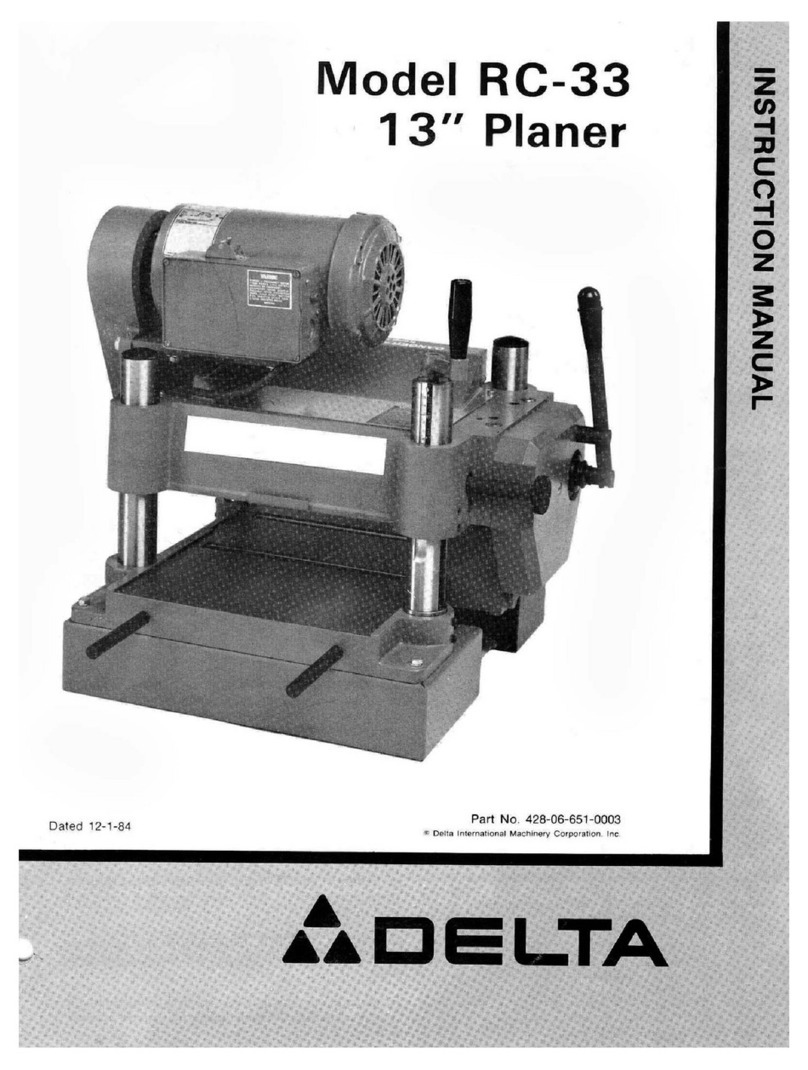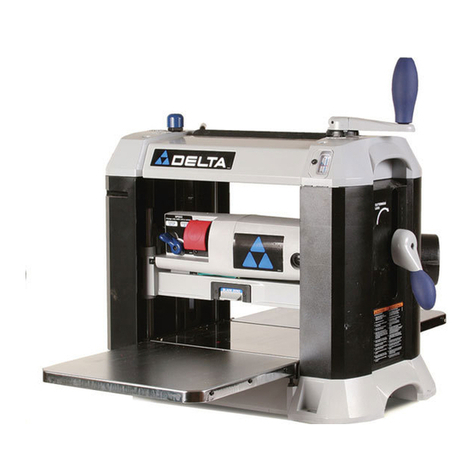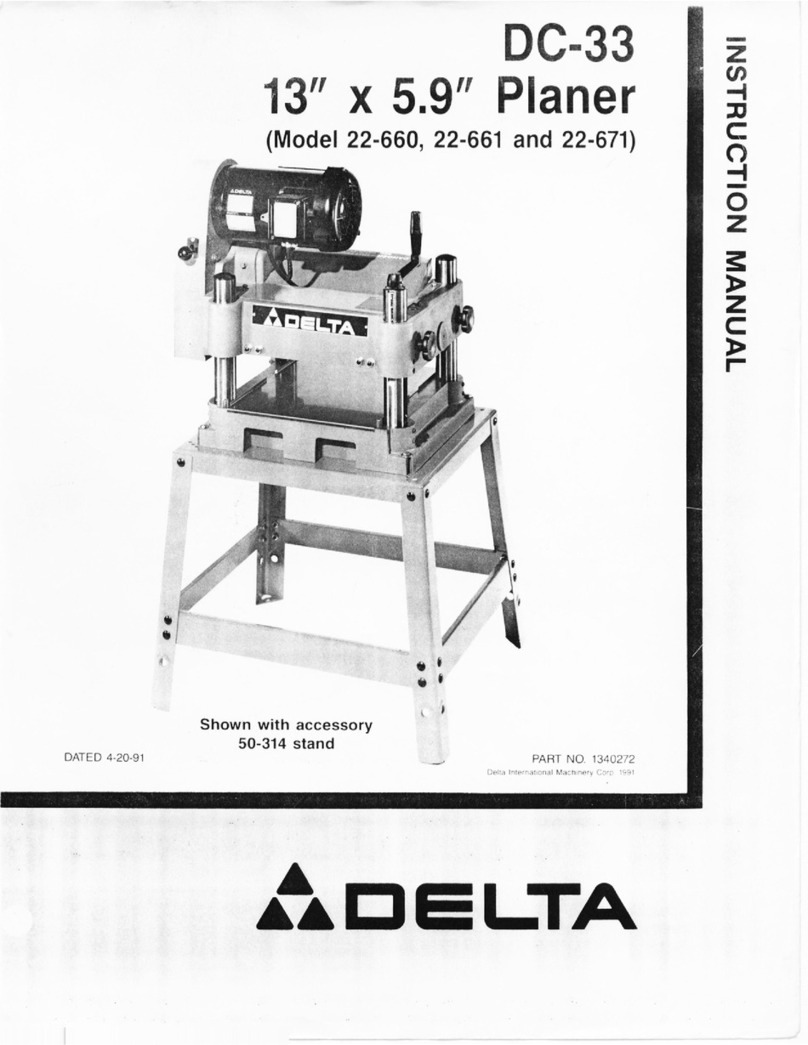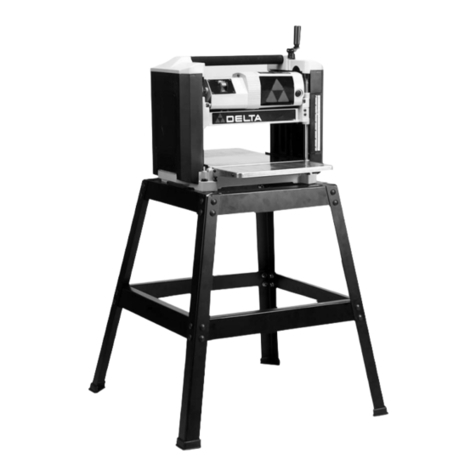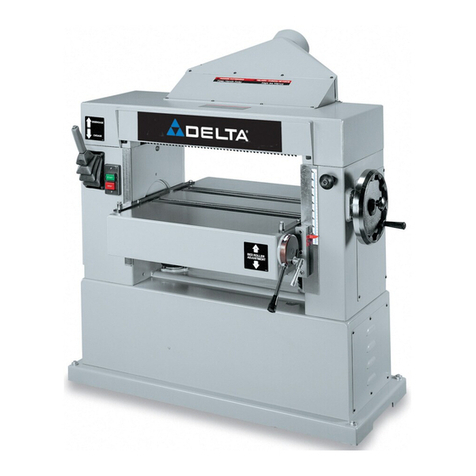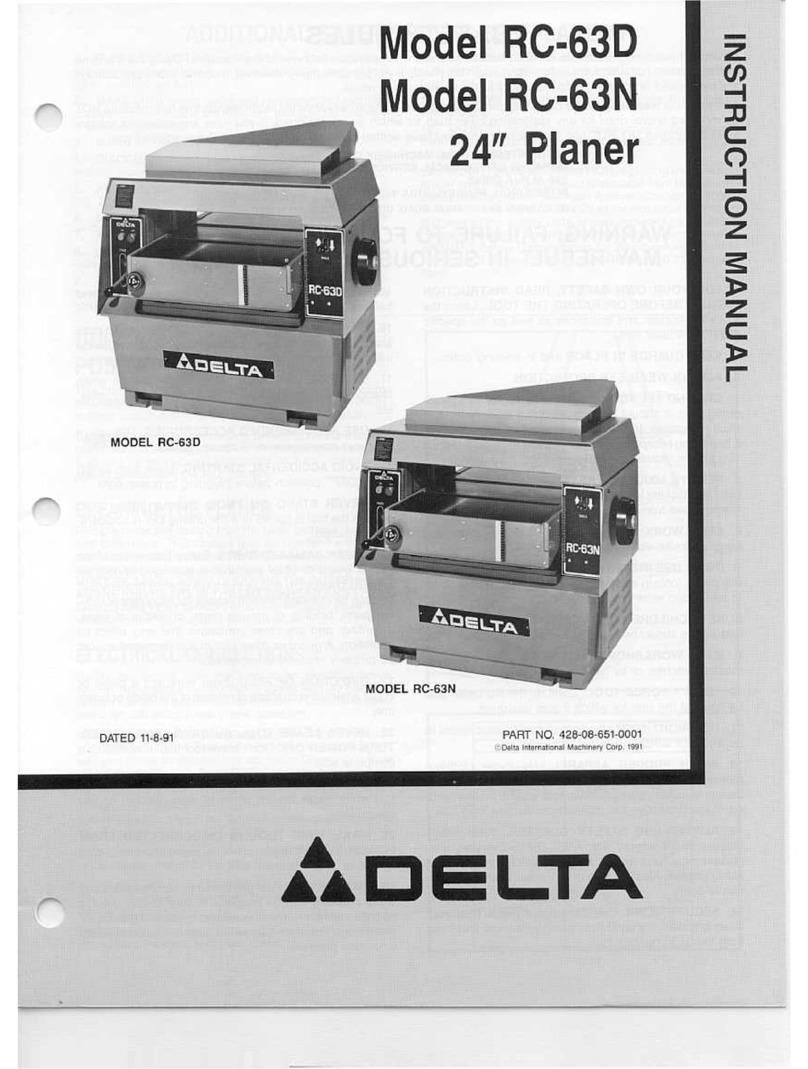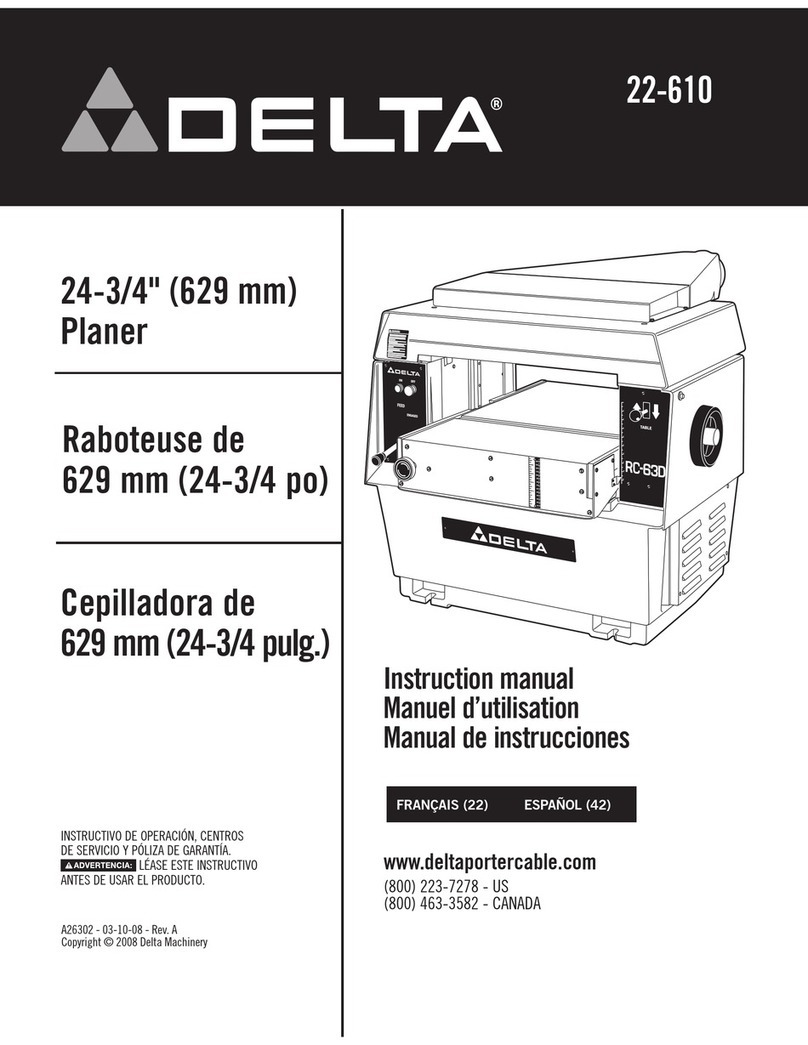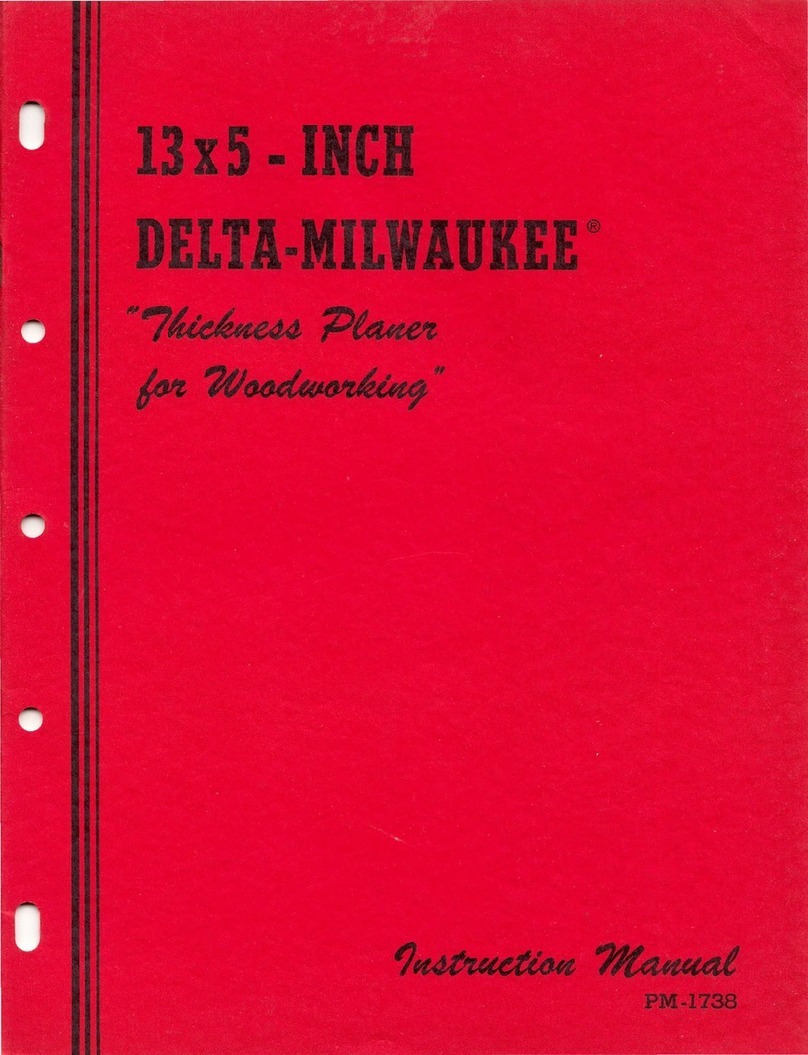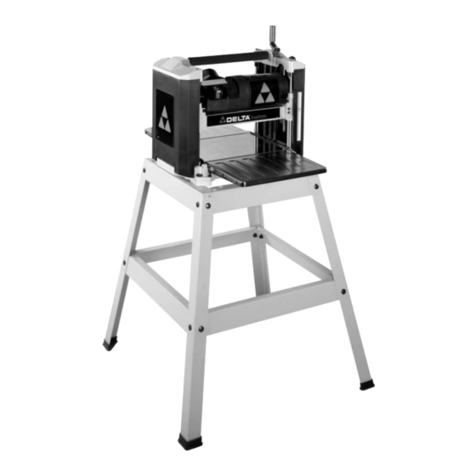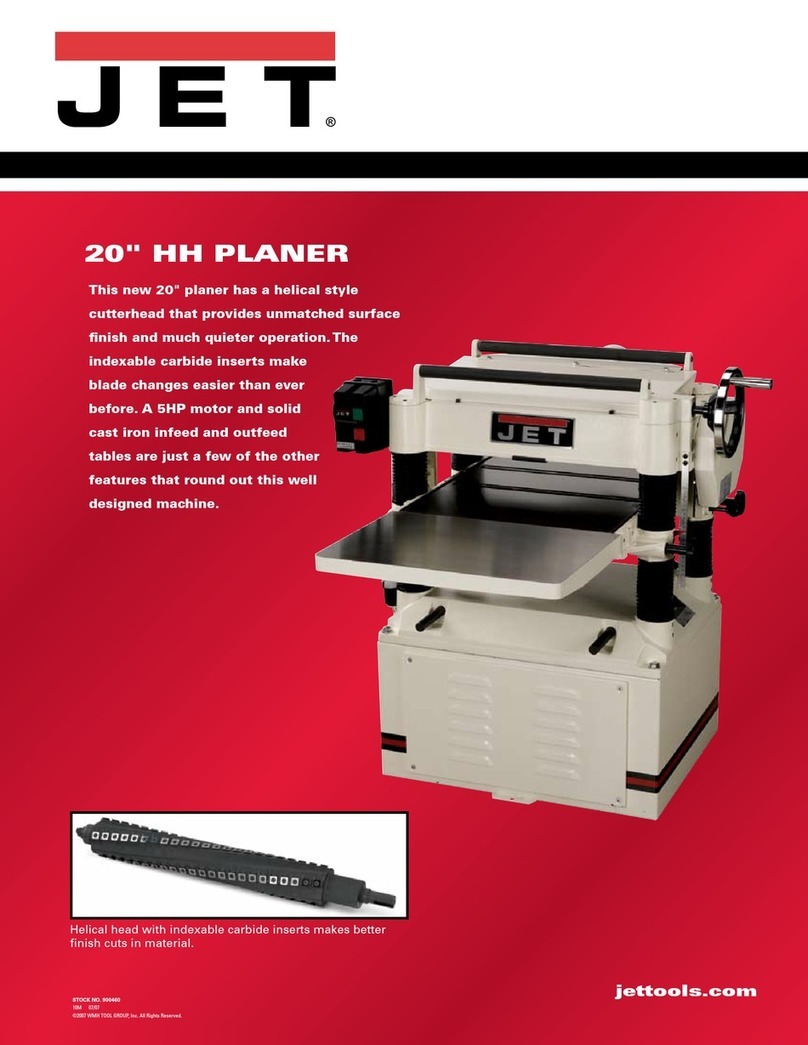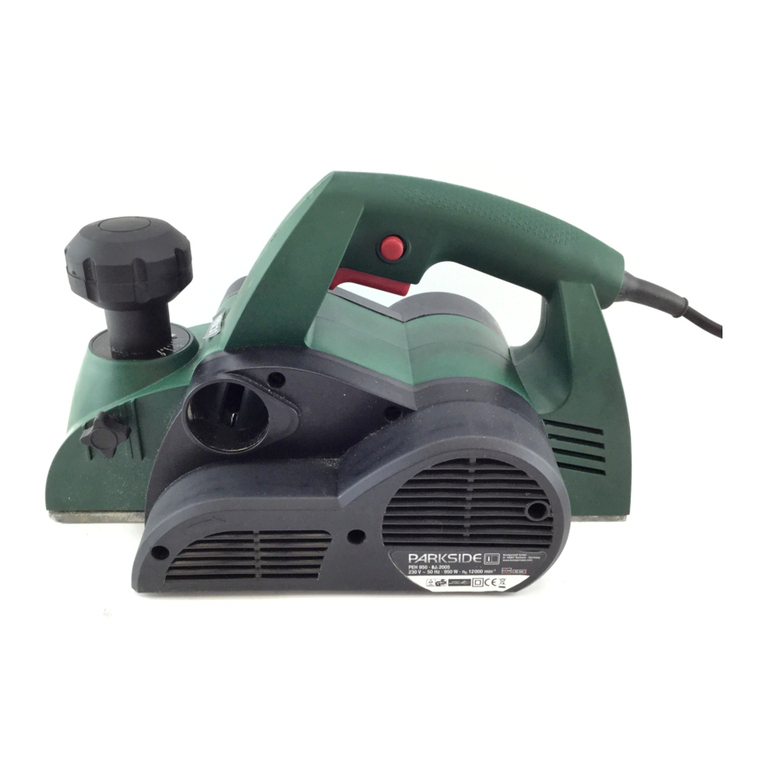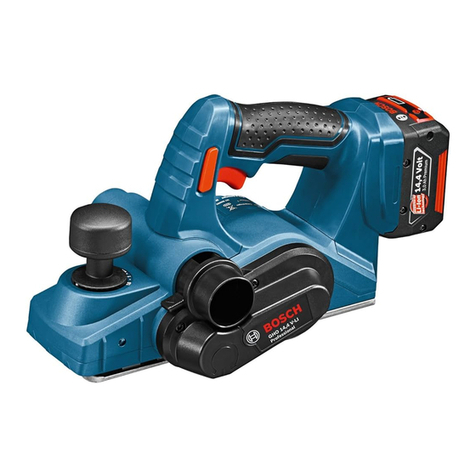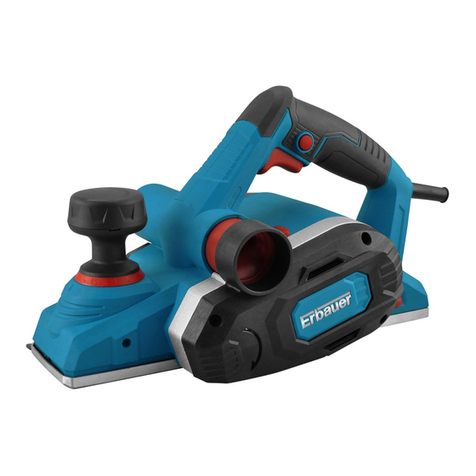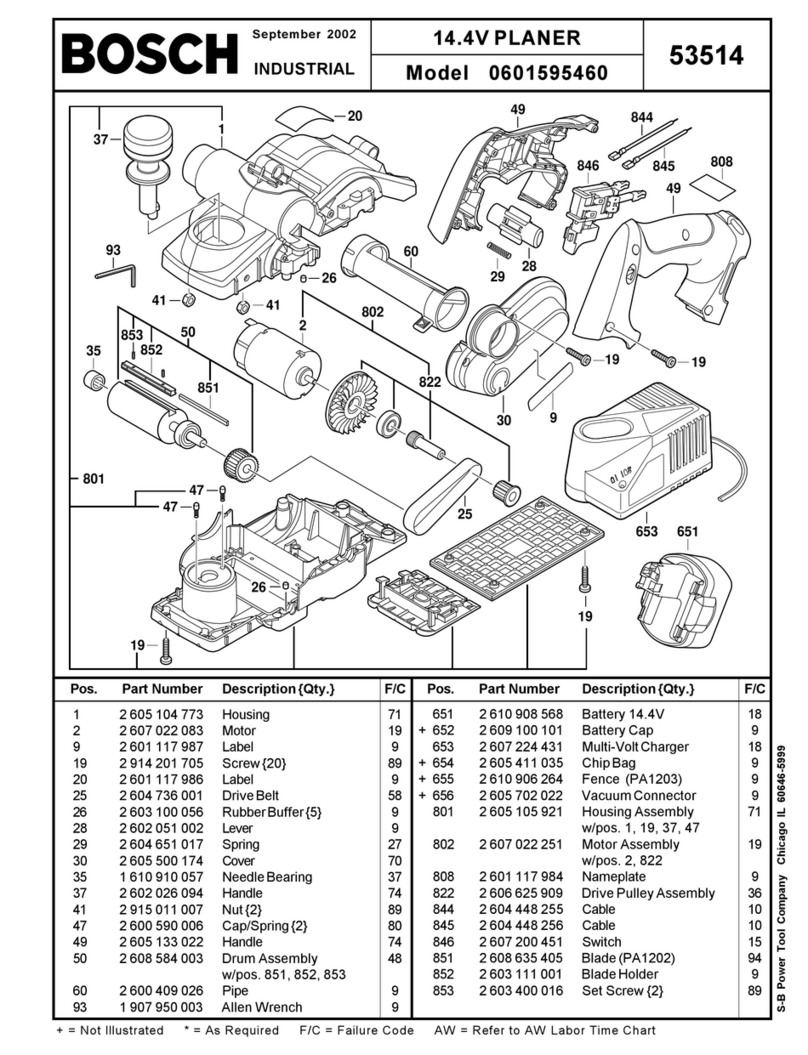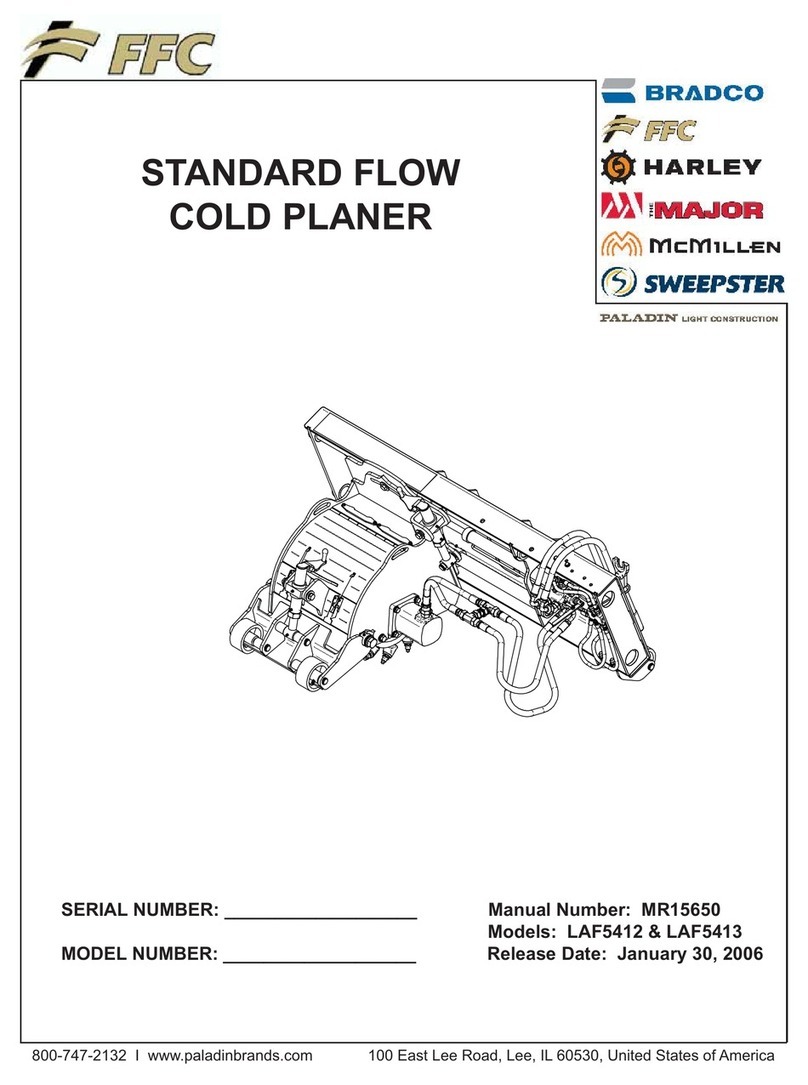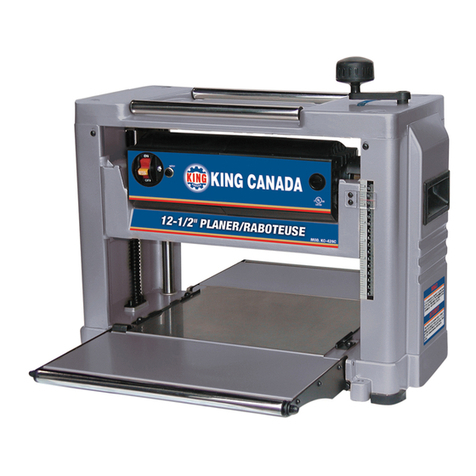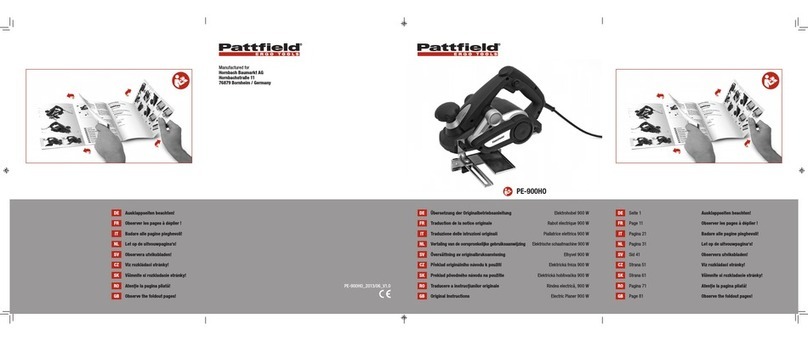Delta 22-555 User manual

22-555
CEPILLO DE BANCO DE
330 mm 13 PLUG.
RABOTEUSE D'ÉTABLI
DE 330 mm (13 PO)
Instruction Manual
Manuel d’utilisation
Manual de instrucciones
Français (16)
Español (30)
INSTRUCTIVO DE OPERACIÓN, CENTROS
DE SERVICIO Y PÓLIZA DE GARANTÍA.
LÉASE ESTE INSTRUCTIVO
ANTES DE USAR EL PRODUCTO.
www.DeltaMachinery.com
13 in. BENCH PLANER

TABLE OF CONTENTS
IMPORTANT SAFETY INSTRUCTIONS...................................2
SAFETY GUIDELINES - DEFINITIONS....................................3
GENERAL SAFETY RULES ......................................................3
ADDITIONAL SPECIFIC SAFETY RULES ...............................4
POWER CONNECTIONS ..........................................................6
MOTOR SPECIFICATIONS .......................................................6
GROUNDING INSTRUCTIONS ................................................6
EXTENSION CORDS ................................................................7
KEY FEATURES AND COMPONENTS ....................................7
FUNCTIONAL DESCRIPTION ..................................................7
PRODUCT SPECIFICATIONS...................................................8
UNPACKING ..............................................................................8
ASSEMBLY.................................................................................9
Attach Height Adjustment Handle.......................................9
Attach Reversible Dust Port................................................9
Connecting to Dust Collector..............................................9
OPERATION.............................................................................10
Starting and Stopping the Planer......................................10
Locking the Planer Using the Safety Key .........................10
Resetting the On-Board Circuit Breaker...........................10
Adjusting Cutting Height ..................................................10
Eliminating Snipe...............................................................11
MAINTENANCE ......................................................................12
Changing the Cutter Knives..............................................12
OTHER RECOMMENDED MAINTENANCE..........................12
ACCESSORIES........................................................................13
WARRANTY .............................................................................13
REPLACEMENT PARTS..........................................................14
SERVICE AND REPAIRS.........................................................14
FRANÇAIS................................................................................16
ESPAÑOL .................................................................................30
IMPORTANT SAFETY INSTRUCTIONS
READ AND UNDERSTAND ALL WARNINGS AND OPERATING INSTRUCTIONS BEFORE USING
THIS EQUIPMENT. Failure to follow all instructions listed below, may result in electric shock, fire, and/or
serious personal injury or property damage.
Woodworking can be dangerous if safe and proper operating procedures are not followed. As with all
machinery, there are certain hazards involved with the operation of the product. Using the machine with
respect and caution will considerably lessen the possibility of personal injury. However, if normal safety
precautions are overlooked or ignored, personal injury to the operator may result. Safety equipment such as
guards, push sticks, hold-downs, featherboards, goggles, dust masks and hearing protection can reduce your potential
for injury. But even the best guard won’t make up for poor judgment, carelessness or inattention. Always use common
sense and exercise caution in the workshop. If a procedure feels dangerous, don’t try it. Figure out an alternative
procedure that feels safer. REMEMBER: Your personal safety is your responsibility. For additional information please
visit our website www.DeltaMachinery.com.
This machine was designed for certain applications only. DELTA®Power Equipment Corporation
strongly recommends that this machine not be modified and/or used for any application other than that
for which it was designed. If you have any questions relative to a particular application, DO NOT use the machine until
you have first contacted DELTA®to determine if it can or should be performed on the product.
If you have any questions relative to its application DO NOT use the product until you have written DELTA®Power
Equipment Corporation and we have advised you. Contact us online at www.DeltaMachinery.com or by mail at Technical
Service Manager, DELTA®Power Equipment Corporation, 2651 NewCut Road, Spartanburg, South Carolina 29303.
Information regarding the safe and proper operation of this tool is available from the following sources:
•Power Tool Institute, 1300 Sumner Avenue, Cleveland, OH 44115-2851or online at www.powertoolinstitute.com
•National Safety Council, 1121 Spring Lake Drive, Itasca, IL 60143-3201
•American National Standards Institute, 25 West 43rd Street,4floor, New York, NY 10036 www.ansi.org - ANSI 01.1
Safety Requirements for Woodworking Machines
•U.S. Department of Labor regulations www.osha.gov
2
Note: This equipment has been tested and found to comply with the limits for a Class A digital device, pursuant to part
15 of the FCC Rules. These limits are designed to provide reasonable protection against harmful interference when the
equipment is operated in a commercial environment. This equipment generates, uses, and can radiate radio frequency
energy and, if not installed and used in accordance with the instruction manual, may cause harmful interference to radio
communications. Operation of this equipment in a residential area is likely to cause harmful interference in which case
the user will be required to correct the interference at his own expense.

SAFETY GUIDELINES - DEFINITIONS
This manual contains information that is important for you to know and understand. This information relates to protecting
YOUR SAFETY and PREVENTING EQUIPMENT PROBLEMS. To help you recognize this information, we use the
symbols below. Please read the manual and pay attention to these sections.
Indicates an imminently hazardous situation which, if not avoided, will result in death or serious injury.
Indicates a potentially hazardous situation which, if not avoided, could result in death or serious injury.
Indicates a potentially hazardous situation which, if not avoided, may result in minor or moderate injury.
Used without the safety alert symbol indicates potentially hazardous situation which, if not avoided, may
result in property damage.
GENERAL SAFETY RULES
WARNING FAILURE TO FOLLOW THESE RULES MAY RESULT IN SERIOUS PERSONAL INJURY.
• For your own safety, read and understand the instruction manual before operating the unit. Learn the unit’s application
and limitations as well as the specific hazards peculiar to it.
• Keep work area clean. Cluttered areas and benches invite accidents.
• Don’t use in dangerous environment. Don’t use this unit in damp or wet locations, or expose it to rain. Keep work area
well-lighted.
• Keep children and visitors away. All children and visitors should be kept a safe distance from work area.
• Disconnect unit before servicing.
• Check damaged parts. Before further use of the unit, properly repair or replace any part that is damaged.
1. Read and understand the warnings posted on the
machine and in this manual. Failure to comply with all
of these warnings may cause serious injury.
2. Replace the warning labels if they become obscured
or removed.
3. This machine is designed and intended for use by
properly trained and experienced personnel only.
If you are not familiar with the proper and safe
operation of a planer, do not use until proper training
and knowledge have been obtained.
4. Do not use this machine for other than its intended
use. If used for other purposes, DELTA®Power
Equipment Corporation disclaims any real or implied
warranty and holds itself harmless from any injury
that may result from that use.
5. Always wear approved safety glasses/face shields
while using this grinder.
6. operating this grinder, remove tie, rings, watches
and other jewelry, and roll sleeves up past the
elbows. Remove all loose clothing and confine long
hair. Non-slip footwear or anti-skid floor strips are
recommended. Do not wear gloves.
7. Wear ear protectors (plugs or muffs) during extended
periods of operation.
8. Some dust created by power sanding, sawing,
grinding, drilling and other construction activities
FAILURE TO FOLLOW THESE RULES MAY RESULT IN SERIOUS INJURY.
contain chemicals known to cause cancer, birth
defects or other reproductive harm. Some examples
of these chemicals are:
• Lead from lead based paint.
• Crystalline silica from bricks, cement and other
masonry products.
• Arsenic and chromium from chemically treated lumber.
Your risk of exposure varies, depending on how often
you do this type of work. To reduce your exposure
to these chemicals, work in a well-ventilated area and
work with approved safety equipment, such as face or
dust masks that are specifically designed to filter out
microscopic particles.
9. Do not operate this machine while tired or under the
influence of drugs, alcohol or any medication.
10. Make certain the switch is in the OFF position before
connecting the machine to the power source.
11. Make certain the machine is properly grounded.
12.Make all machine adjustments or maintenance with
the machine unplugged from the power source.
13.Form a habit of checking to see that all extra
equipment such as adjusting keys, wrenches, scrap,
continued on page 4
3
5. Always wear approved safety glasses/face shields
while using this tool.
6. Before operating this tool, remove tie, rings, watches
and other jewelry, and roll sleeves up past the
elbows. Remove all loose clothing and confine long
hair. Non-slip footwear or anti-skid floor strips are
recommended. Do not wear gloves.
3. This machine is designed and intended for use by
properly trained and experienced personnel only.
If you are not familiar with the proper and safe
operation of a planer, do not use until proper training
and knowledge have been obtained.

stock, and cleaning rags are removed away from the
machine before turning on.
14.Keep safety guards in place at all times when the
machine is in use. If removed for maintenance
purposes, use extreme caution and replace the
guards immediately when maintenance is complete.
15. Make sure the tool is firmly secured to a stable work
surface before use.
16.Check damaged parts. Before further use of the
machine, a guard or other part that is damaged
should be carefully checked to determine that it will
operate properly and perform its intended function.
Check for alignment of moving parts, binding of
moving parts, breakage of parts, mounting and any
other conditions that may affect its operation. A guard
or other part that is damaged should be properly
repaired or replaced.
17.Provide for adequate space surrounding work area
and non-glare, overhead lighting.
18. Keep the floor around the machine clean and free of
scrap material, oil and grease.
19.Keep visitors a safe distance from the work area.
Keep children away.
20.Make your workshop child proof with padlocks,
master switches or by removing starter keys.
21. Give your work undivided attention. Looking around,
carrying on a conversation and “horse-play" are
careless acts that can result in serious injury.
22. Maintain a balanced stance at all times so that you do
not fall or lean against the tool or its moving parts. Do
not overreach or use excessive force to perform any
machine operation.
23. Use the right tool at the correct speed and feed rate.
Do not force a tool or attachment to do a job for
which it was not designed. The right tool will do the
job better and safer.
24.Use recommended accessories; improper
accessories may be hazardous.
25. Maintain machinery with care. Follow instructions for
lubricating and changing accessories.
26. Turn off the machine before cleaning. Use a brush or
compressed air to remove dust or debris — do not
use your hands.
27. Do not stand on the machine. Serious injury could
occur if the machine tips over.
28. Never leave the machine running unattended. Turn
the power off and do not leave the machine until it
comes to a complete stop.
29. At all times, hold the stock firmly.
30. Do not use this tool for other than it intended use. If
used for other purposes, DELTA®Power Equipment
Corporation disclaims any real or implied warranty
and holds itself harmless for any injury or damage
which may result from that use.
Familiarize yourself with the following safety notices
used in this manual:
This means that if precautions are not heeded, it may
result in minor injury and/or possible machine damage.
This means that if precautions are not heeded, it may
result in serious injury or possibly even death.
4
ADDITIONAL SPECIFIC SAFETY RULES
1. Do not operate this machine until it is completely
assembled and installed according to the
instructions. A machine incorrectly assembled can
cause serious injury
2. Obtain advice from your supervisor, instructor, or
another qualified person if you are not thoroughly
familiar with the operation of this machine.
Knowledge is safety.
3. Follow all wiring codes and recommended electrical
connections to prevent shock or electrocution.
4. Keep knives sharp and free from rust and pitch.
Dull or rusted knives work harder and can cause
kickback.
5. Never turn the machine “on” before clearing the table
of all objects (tools, scraps of wood, etc.).
6. Flying debris can cause serious injury.
7. Never turn the machine “on” with the workpiece
contacting the cutter head. Kickback can occur.
8. Secure the machine to a supporting surface to
prevent the machine from sliding, walking or tipping
over.
9. Properly secure the knives in the cutterhead before
turning the power “on”. Loose blades may be thrown
out at high speeds causing serious injury.
10. Avoid awkward operations and hand positions. A
sudden slip could cause a hand to move into the
knives.
11. Keep arms, hands, and fingers away from the cutter
head, the chip exhaust opening, and the feed rollers
to prevent severe cuts.
Failure to follow these rules may result in serious personal injury.

5
SAVE THESE INSTRUCTIONS.
Refer to them often and use them to instruct others.
12.Never reach into the cutterhead area while the
machine is running. Your hands can be drawn into the
knives.
13.Do not stand in line of the workpiece. Kickback can
cause injury.
14.Allow the cutterhead to reach full speed before
feeding a workpiece.
15.When planing bowed stock, place the concave (cup
down) side of the stock on the table and cut with the
grain to prevent kickback.
16.Do not feed a workpiece that is warped, contains
knots, or is embedded with foreign objects (nails,
staples,etc.). Kickback can occur.
17.Do not feed a short, thin, or narrow workpiece into
the machine. Your hands can be drawn into the
knives and/or the workpiece can be thrown at high
speeds. See the “operation” section of this instruction
manual for details.
18.Do not feed a workpiece into the outfeed end of the
machine. The workpiece will be thrown out of the
opposite side at high speeds.
19.Remove shavings only with the power “off” to prevent
serious injury.
20.Properly support long or wide workpieces. Loss of
control of the workpiece can cause serious injury.
21.Never perform layout, assembly or set-up work on
the table/work area when the machine is running.
Serious injury will result.
22.Turn the machine “off”, disconnect it from the power
source, and clean the table/work area before leaving
the machine. Lock the switch in the “off” position
to prevent unauthorized use. Someone else might
accidentally start the machine and cause injury to
themselves or others..
23.Additional information regarding the safe and
proper operation of power tools (i.E. A safety video)
is available from the power tool institute, 1300
sumner avenue, cleveland, oh 44115-2851 (www.
Powertoolinstitute.Com). Information is also available
from the national safety council, 1121 spring lake
drive, itasca, il 60143-3201. Please refer to the
american national standards institute ansi 01.1 Safety
requirements for woodworking machines and the u.S.
Department of labor osha 1910.213 Regulations.
ADDITIONAL SPECIFIC SAFETY RULES

1. All grounded, cord-connected machines:
In the event of a malfunction or breakdown, grounding provides a path of least resistance for electric current to reduce
the risk of electric shock. This machine is equipped with an electric cord having an equipment-grounding conductor and
a grounding plug. The plug must be plugged into a matching outlet that is properly installed and grounded in accordance
with all local codes and ordinances.
Do not modify the plug provided - if it will not fit the outlet, have the proper outlet installed by a qualified electrician.
Improper connection of the equipment-grounding conductor can result in risk of electric shock. The conductor with
insulation having an outer surface that is green with or without yellow stripes is the equipment-grounding conductor. If
repair or replacement of the electric cord or plug is necessary, do not connect the equipment-grounding conductor to a
live terminal.
Check with a qualified electrician or service personnel if the grounding instructions are not completely understood, or if
in doubt as to whether the machine is properly grounded.
Use only 3-wire extension cords that have 3-prong grounding type plugs and matching 3-conductor receptacles that
accept the machine’s plug, as shown in Fig. A.
Repair or replace damaged or worn cord immediately.
IN ALL CASES, MAKE CERTAIN THE RECEPTACLE IN QUESTION IS PROPERLY GROUNDED.
IF YOU ARE NOT SURE, HAVE A QUALIFIED ELECTRICIAN CHECK THE RECEPTACLE.
GROUNDING INSTRUCTIONS
THIS MACHINE MUST BE GROUNDED WHILE IN USE TO PROTECT THE OPERATOR FROM
ELECTRIC SHOCK.
A separate electrical circuit should be used for your machines. This circuit should not be less than #14 wire and should
be protected with a 20 Amp time lag fuse. If an extension cord is used, use only 3-wire extension cords which have
3-prong grounding type plugs and matching receptacle which will accept the machine’s plug. Before connecting the
machine to the power line, make sure the switch (s) is in the "OFF" position and be sure that the electric current is of
the same characteristics as indicated on the machine. All line connections should make good contact. Running on low
voltage will damage the machine.
DO NOT EXPOSE THE MACHINE TO RAIN OR OPERATE THE MACHINE IN DAMP LOCATIONS.
FIG. A FIG. B
GROUNDED
OUTLET BOX
CURRENT
CARRYING
PRONGS
GROUNDING BLADE
IS LONGEST OF THE 3 BLADES
GROUNDED OUTLET BOX
GROUNDING
MEANS
ADAPTER
POWER CONNECTIONS
6
MOTOR SPECIFICATIONS
Your machine is wired for 120 Volts, 60 Hz alternating current. Before connecting the machine to the power source,
make sure the switch is in the “OFF” position.

EXTENSION CORDS
Use proper extension cords. Make
sure your extension cord is in good
condition and is a 3-wire extension cord which has
a 3-prong grounding type plug and matching
receptacle which will accept the machine’s plug.
When using an extension cord, be sure to use one
heavy enough to carry the current of the machine.
An undersized cord will cause a drop in line
voltage, resulting in loss of power and overheating.
The table shows the correct gauge to use
depending on the cord length. If in doubt, use the
next heavier gauge. The smaller the gauge number,
the heavier the cord.
MINIMUM GAUGE EXTENSION CORD
RECOMMENDED SIZES FOR USE WITH STATIONARY ELECTRIC MACHINES
Ampere
Rating Volts Total Length
of Cord in
Feet
Gauge of Extension
Cord
0-6
0-6
0-6
0-6
120
120
120
120
up to 25
25-50
50-100
100-150
18 AWG
16 AWG
16 AWG
14 AWG
6-10
6-10
6-10
6-10
120
120
120
120
up to 25
25-50
50-100
100-150
18 AWG
16 AWG
14 AWG
12 AWG
10-12
10-12
10-12
10-12
120
120
120
120
up to 25
25-50
50-100
100-150
16 AWG
16 AWG
14 AWG
12 AWG
12-16
12-16
12-16
120
120
120
up to 25
25-50 14 AWG
12 AWG
GREATER THAN 50 FEET NOT RECOMMENDED
7
KEY FEATURES AND COMPONENTS
A. Feed Table
B. ON/OFF Switch
C. Circuit Breaker Reset
D. 15 Amp, 120V Motor
E. Height Adjustment Handle
F. 2” Reversible Dust Port
G. Height Indicator
FUNCTIONAL DESCRIPTION
The DELTA®22-555 is a 13" (317mm) Portable Planer. This planer can handle workpieces up to 13" (317mm) wide
and 6" (152mm) thick. The maximum depth of cut is 3/32" (2.4 mm). The 22-555 features a powerful 15 Amp, 120 Volt
motor, a two-knife cutter head with double-edged reversible knives, knife-installation tool and wrench.
A
B
CDE
F
G

8
Compare all parts to the list below and check that all parts are present and in good condition. Report any missing or
damaged parts to your distributor or dealer. Prior to tool assembly and use, read this manual thoroughly to familiarize
yourself with proper assembly, maintenance and safety procedures.
PRODUCT SPECIFICATIONS
UNPACKING
DESCRIPTION (QUANTITY)
1. DELTA® Model #22-555 Planer (1)
2. Height Adjustment Handle (1)
3. Reversible 2” Dust Port (1)
4. Knife Transfer Tool (2)
5. T-wrench (not shown)
HARDWARE PACKAGE
• 4mm T-handle Hex Wrench
• M5x16mm Hex Head Screw (1)
• M5 Flat Washer
• M6x15mm Lock Knob (2)
Remove any protective materials and coatings from all of the parts and the tool. The protective coatings can be removed
by spraying WD-40 on them and wiping it off with a soft cloth. This may need redone several times before all of the
protective coatings are removed completely.
If any parts are missing, do not attempt to plug in the power cord and turn “ON” the machine. The
machine should only be turned “ON” after all the parts have been obtained and installed correctly.
Cuts Per Minute 18,800
Feed Rate 28ft./min.
Max. Cut Depth (per pass) 3/32”
Max. Cutting Width 12- ½ “
Max. Cutting Height 6”
Cutterhead Speed 9,400 RPM
Tool Dimensions (LxWxH) 21-5/8” x 23-5/8” x 20-1/8”
Motor 15 Amp, 120V
Net Weight 58 lbs
Knife Type Double-edge reversible
Number of Knives 2
Knife Size (L x W x T) 320mm x12mm x1.5mm
12
3
4
5

9
ATTACH HEIGHT ADJUSTMENT HANDLE
Refer to Figure 1
1. Remove the rubber cap (A) from the top of the height
adjustment crank shaft (B).
2. Use an M5 x 16mm hex head screw, M5 flat washer,
and supplied t-handle hex wrench to secure the
height adjustment handle to shaft (C).
3. Replace the rubber cap.
FIGURE 1
ASSEMBLY
FIGURE 2
A
B
C
ATTACH REVERSIBLE DUST PORT
Refer to Figure 2
The 22-555 planer features a reversible dust port that can
be attached for left-sided or right-sided dust collection.
To attach the dust port:
1. Secure the dust port (A) to the tool housing on both
ends use the two M6 x 15mm lock knobs (B).
A
B
B
CONNECTING TO DUST COLLECTOR
A planer creates a large amount of fine particles while in use. It is strongly recommended that you connect the planer to
a shop vacuum or dust collector. Your DELTA® Bench Planer is equipped with a 2” dust port that must be connected
to a vacuum hose to ensure safe operation. Using a 2" to 4" adapter, sold separately, will enable you to connect your
planer to most dust collectors that use a 4” hose.
Do not attempt to operate this tool without first connecting it to an adequate dust collection
system.
Always turn on the dust collector before starting the planer and always stop the planer before
turning off the dust collector.

10
STARTING AND STOPPING THE PLANER
LOCKING THE PLANER USING THE SAFETY KEY
OPERATION
Make sure that the switch is in the "OFF" position before plugging cord into outlet. Do not touch
the plug’s metal prongs when unplugging or plugging in the cord.
In the event of a power outage (such as a breaker or fuse trip), always move the switch to the
"OFF" position until the main power is restored.
The ON/OFF switch (A), indicated in Figure 3, is located on the front of the cabinet. To turn the machine “ON,” move the
switch to the up position. To turn the machine “OFF,” move the switch to the down position.
FIGURE 3
1. This machine uses a safety key (B), shown in Figure 3,
that enables you to lock the tool in the “OFF” position
when not in use.
IMPORTANT: When the machine is not in use, the
switch should be locked in the "OFF" position to prevent
unauthorized use.
2. To lock the machine, remove the safety key by pulling
it straight out. With the safety key removed, the
switch will not operate.
3. Should the safety key be removed while the tool
is running, the machine can be turned "OFF,"
but cannot be restarted unless the safety key is
re-inserted.
RESETTING THE ON-BOARD CIRCUIT BREAKER
As an additional safety feature, the DELTA®22-555 has an on-board
circuit breaker (C), shown in Figure 3. Should the motor become
overloaded or should a power surge occur while the machine is
operating, the circuit breaker will trip, cutting power to the machine.
In the event the breaker trips, do the following:
1. Turn the machine off and unplug the power cord.
2. Raise the cutterhead and remove the workpiece from the machine.
3. Wait 2 to 3 minutes or until the motor housing is cool to the touch,
then depress the on-board circuit breaker reset.
4. Plug the power cord in and restart the machine using the ON/OFF
switch.
5. If the machine fails to start, allow the motor to cool further and
attempt to reset the breaker again.
A
B
C
ADJUSTING CUTTING HEIGHT
Refer to Figure 4
Your DELTA®22-555 Bench Planer can accept stock up
to 6” in height and has a maximum cutting depth of 3/32”
per pass. To adjust the height of the cutterhead:
1. Rotate the Height Adjustment Handle until the Height
Indicator (A) is pointing to the desired height. Turning
the handle clockwise raises the cutterhead while
turning it counterclockwise lowers it. One complete
revolution of the Height Adjustment Handle moves
the cutterhead 1/16”.
FIGURE 4
A

11
OPERATION
ELIMINATING SNIPE
Snipe is a short depression created at the beginning
and/or end of a board after it passes through the
planer. Figure 5 shows how snipe occurs when a board
enters the cutting area of the planer with the leading
end elevated. The same effect can be created when
the trailing end of the board becomes elevated as the
workpiece exits the planer.
There are a few ways you can control snipe.
The most common cause of snipe is failure to fully
support the workpiece as the leading end enters the
planer and as the trailing end exits the planer. This can
be addressed by securely holding the workpiece to the
surface of the infeed table and not allowing the leading
end to elevate as it contacts the cutterhead.
If, after trying the above, snipe is still present,
try lessening the depth of cut by slightly raising the
height of the cutterhead (see previous section, “Height
Adjustment”).
FIGURE 5
FIGURE 6
A
B
If the workpiece continues to exhibit snipe, you may
need to adjust the height of the infeed and or outfeed
table. To do this, see Figure 6, then:
1. Fold the infeed and outfeed tables up in order to
locate the two infeed (A) and two outfeed (B) stop
screws.
2. Using a 10mm open wrench, loosen the retaining
nuts.
3. Adjust the stop screws, one set at a time, making
sure that they are at the same height. To check the
screw height, lower the table and confirm that both
screw heads are flush against the bottom of the table.
4. Re-test for snipe.

12
MAINTENANCE
CHANGING OR REVERSING KNIVES
Disconnect the machine from the
power source before making any
adjustments!
Planer knives are dangerously sharp.
Use extreme caution when inspecting,
removing, sharpening, or replacing knives into the cutter
head. Failure to comply may cause serious injury.
1. Remove the dust chute by unscrewing the two lock
knobs shown in Figure 2.
2. Remove the two lock knobs securing the cutterhead
cover to the main casting and remove the cover. The
cutterhead and the knives will now be exposed.
3. Lock the cutterhead in place. To do this, refer to
Figure 7 and ensure the red spring-loaded lock tab (A)
is in the forward position. Then carefully and slowly
rotate the cutterhead until the tab locks in place and
the cutterhead does not move.
4. Using the T-handle hex wrench supplied, loosen the
six screws (B) securing each knife hold down bar and
the knife to the cutterhead.
5. Use the magnetic end of the knife removal tool (C) to
carefully lift off the hold down bar and then the knife.
Blades are sharp! Use great care when
FIGURE 7
OTHER RECOMMENDED MAINTENANCE
1. Periodically blow out all air passages with dry compressed air. All plastic parts should be cleaned with a soft damp
cloth. NEVER use solvents to clean plastic parts. They could possibly dissolve or otherwise damage the material.
2. Periodically check tightness on all other hardware and listen for any unusual vibrations as you work as these may be
a sign of loose hardware.
hands are around blade area!
6. Carefully install the new knife or rotate the existing
knife, ensuring the pins on the cutterhead align with
the elongated holes in the knife.
7. Replace the hold down bar, making sure that the two
pins on the cutterhead are aligned with the two small
holes in the hold down bar.
8. Replace and retighten the six screws.
9. Unlock the cutterhead by moving the red spring-
loaded lock tab forward and carefully rotating the
cutterhead until the second knife is exposed and the
cuttterhead locks into place.
10. Repeat Steps 4 – 8 to replace the second knife.
11. Replace the cutterhead cover. Ensure the notches in
the cover align with the threaded holes and the cover
is fully seated in the recess.
12. Replace the dust chute and re-secure with the two
lock knobs.
A
B
C

ACCESSORIES
A complete line of accessories is available from your DELTA®Supplier, DELTA®Factory Service Centers, and DELTA®
Factory Service Centers, and DELTA®Authorized Service Centers. Please visit our Web Site www.DeltaMachinery.
com for an online catalog or for the name or your nearest supplier.
Since accessories other than those offered by DELTA®have not been tested with this product,
use of such accessories could be hazardous. For safest operation, only DELTA®recommended
accessories should be used with this product.
WARRANTY
To register your tool for warranty service visit our website at www.DeltaMachinery.com.
LATIN AMERICA: This warranty does not apply to products sold in Latin America. For products sold in Latin America, see country
specific warranty information contained in the packaging, call the local company or see website for warranty information.
FIVE YEAR LIMITED WARRANTY
Delta® Power Equipment Corporation
1. WHAT IS COVERED. Delta Power Equipment Corporation (“Company”) will repair or replace, at its option, any new or factory refurbished
DELTA® machine or service part which is purchased at retail in the United States or Canada and which in normal use has proven to be defective
in workmanship or material, subject to the conditions stated in this Limited Warranty. This Limited Warranty covers only materials and labor.
All transportation costs are Customer’s responsibility.
2. WARRANTY PERIOD. All warranty claims must be submitted within five years from the date of retail purchase. For all service parts and
factory refurbished DELTA® machines, the warranty period is 180 days.
3. HOW TO OBTAIN SERVICE. To obtain warranty service, you must return the defective product, at your expense, to a service center authorized
by Company to perform warranty service (a “DELTA® Authorized Service Center”) within the applicable warranty period, together with
acceptable proof of purchase, such as your original receipt bearing the date of purchase, or product registration number. Company reserves
the right to restrict warranty claim service to the country where the purchase was made and/or to charge for the cost to export service parts
or provide warranty service in a different country. On-line purchases are deemed made in the United States. For the location of your nearest
DELTA® Authorized Service Center, call Company’s Customer Care Center at (800) 223-7278.
4. EXCLUSIONS.
· Company does not offer any warranty on products purchased in used or damaged condition.
· Company does not warranty any products purchased outside the United States or Canada
· Company will not be responsible for any damage that has resulted from normal wear, misuse, abuse or any repair or alteration made by
anyone other than a DELTA® Authorized Service Center or a designated representative of Company’s Customer Care Center.
· All IMPLIED WARRANTIES are expressly limited to the warranty period identified above.
· Under no circumstances will Company be liable for INCIDENTAL OR CONSEQUENTIAL damages.
· This limited warranty is Company’s sole warranty and sets forth the customer’s exclusive remedy with respect to defective products; all other
warranties, express or implied, whether of merchantability, fitness for purpose, or otherwise, are expressly disclaimed by Company, except as
stated above.
Some states do not allow the exclusion or limitation of incidental or consequential damages, or the limitation of implied warranties, so the
above limitations or exclusions may not apply to you. This warranty gives you specific legal rights and you may have other rights which vary
in certain states or provinces. For further details of warranty coverage and warranty repair information, call (800) 223-7278. To register your
products online, we encourage you to visit our website and register for a FREE DELTA Member Account at http://www.deltamachinery.com/
register.
13

REPLACEMENT PARTS
Use only identical replacement parts. For a parts list or to order parts, visit our website at www.DeltaMachinery.
com. You can also order parts from your nearest factory-owned branch, Authorized Warranty Service Center or by
calling Technical Service Manager at 1-800-223-7278 to receive personalized support from one of our highly-trained
representatives.
FREE WARNING LABEL REPLACEMENT
If your warning labels become illegible or are missing,
call
1-800-223-7278
fora free replacement.
SERVICE AND REPAIRS
All quality tools will eventually require servicing and/or replacement of parts. For information
about DELTA®Power Equipment Corporation, its factory-owned branches, or to locate
an Authorized Wa r ran t y Service Center, visit our website at www.DeltaMachinery.com
or call our Customer Care Center at 1-800-223-7278. All repairs made by our service centers are fully guaranteed
against defective material and workmanship. We cannot guarantee repairs made or attempted by others. By calling
this number you can also find answers to most frequently asked questions.
You can also write to us for information at DELTA®Power Equipment Corporation, 2651 New Cut Road,
Spartanburg, SC 29303 - Attention: Technical Service Manager. Be sure to include all of the information
shown on the nameplate of yourtool (model number, type, serial number, date code, etc.)
PARTS, SERVICE OR WARRANTY ASSISTANCE
All DELTA®machines and accessories are manufactured to high quality standards and are serviced by a network of
DELTA®Factory Service Centers and DELTA®Authorized Service Centers. To obtain additional information regarding
your DELTA®quality product or to obtain parts, service, warranty assistance, or the location of the nearest service center,
please call 1-800-223-7278.
14

15

16
CONSIGNES DE SÉCURITÉ IMPORTANTES
CONSIGNES DE SÉCURITÉ - DÉFINITIONS
ASSUREZ-VOUS D’AVOIR BIEN LU ET COMPRIS TOUTES LES MISES EN GARDE ET LES
CONSIGNES D’UTILISATION AVANT D’UTILISER CET ÉQUIPEMENT. Le fait de ne pas
respecter toutes les instructions ci-dessous pourrait causer une électrocution, des incendies, et/ou des blessures
personnellesou des dommages matériels graves.
La meuleuse peut être dangereuse si des procédures d’utilisation sécuritaires et adéquates ne sont pas
respectées. Comme c’est le cas pour toute pièce de machinerie, l’utilisation de ce produit comporte
certains dangers. En utilisant cet appareil selon les directives et avec prudence, vous réduirez de façon
importante les risques de blessures corporelles. Cependant, si les précautions normales de sécurité
sont négligées ou ignorées, la personne qui utilise l’appareil pourrait être blessée. L’équipement de protection
comme les gardes, les poussoirs, les dispositifs de retenue, les planches de protection, les lunettes de sécurité,
les masques antipoussières et la protection pour l’ouïe peut réduire le risque de blessure. Cependant, même le
meilleur dispositif de protection ne peut compenser un mauvais jugement, un manque de prudence ou d'inattention.
Utilisez toujours le bon senset soyez prudent dans l’atelier. Si une manœuvre a l’air dangereuse, ne l’effectuez
pas. Essayez plutôt de trouver un moyen plus facile. RAPPELEZ-VOUS : vous êtes responsable de votre sécurité
personnelle. Pour des renseignements complémentaires, rendez-vous sur notre site Web à l’adresse suivante
www.DeltaMachinery.com.
Cet appareil a été conçu seulement pour certaines utilisations. DELTAMD Power Equipment
Corporation recommande fortement que cet appareil ne soit pas modifié ni utilisé pour toutes
autres fins que celles pour lesquelles il a été conçu. Si vous avez des questions sur une utilisation en particulier,
N’UTILISEZ PAS l’appareil avant d’avoir d’abord communiqué avec DELTAMD pour déterminer si cette utilisation peut ou
si elle devrait être faite sur ce produit.
Si vous avez des questions relativement à son utilisation, N’UTILISEZ PAS le produit tant que vous n’aurez pas
communiqué par écrit avec DELTAMD Power Equipment Corporation et obtenu une réponse de sa part. Contactez-nous en
ligne à www.DeltaMachinery.com ou par courrier à l’adresse suivante : Responsable du service technique, DELTAMD Power
Equipment Corporation, 2651 New Cut Road, Spartanburg, South Carolina 29303.
Des renseignements au sujet de l’utilisation sécuritaire et appropriée de cet appareil sont disponibles auprès des
sources suivantes :
•Power Tool Institute, 1300 Sumner Avenue, Cleveland, OH 44115-2851 ou en ligne sur www.powertoolinstitute.com
•National Safety Council, 1121 Spring Lake Drive, Itasca, IL 60143-3201
•American National Standards Institute, 25 West 43rd Street, 4 floor, New York, NY 10036 www.ansi.org - ANSI 01.1
Safety Requirements for Woodworking Machines
•Réglementation du Département américain du travail (OSHA) à l’adresse www.osha.gov
Ce manuel contient des renseignements qu'il est important de connaître et de comprendre. Ces renseignements ont pour
but d’assurer VOTRE SÉCURITÉ et de PRÉVENIR LES PROBLÈMES D’ÉQUIPEMENT. Pour vous aider à reconnaître ces
renseignements, nousutilisons les symboles ci-dessous. Veuillez lire le manuel et prêter attention à ces sections.
Indique une situation extrêmement dangereuse qui, si elle n’est pas évitée, entraînera la mort ou une
blessure grave.
Indique une situation potentiellement dangereuse qui, si elle n’est pas évitée, pourrait entraîner
la mort ou une blessure grave.
Indique une situation potentiellement dangereuse qui, si elle n’est pas évitée, peut entraîner une
blessure mineure ou modérée.
Utilisé sans le symbole d’avertissement, indique une situation potentiellement dangereuse qui, si elle
n’est pas évitée, peut endommager l’appareil.

17
RÈGLES DE SÉCURITÉ GÉNÉRALES
LE NON-RESPECT DE CES RÈGLES PEUT ENTRAÎNER DES BLESSURES PERSONNELLES
GRAVES.
• POUR VOTRE PROPRE SÉCURITÉ, ASSUREZ-VOUS D’AVOIR BIEN LU ET COMPRIS LE MANUEL D’UTILISATION
AVANT DE FAIRE FONCTIONNER L’APPAREIL. Apprenez à connaître son domaine d’utilisation et ses limites, ainsi que
les dangers qui lui sont rattachés.
• MAINTENEZ L’AIRE DE TRAVAIL PROPRE. Les aires et les bancs de travail encombrés sont propices aux accidents.
• NE PAS UTILISER DANS UN ENVIRONNEMENT DANGEREUX. N’utilisez pas cet appareil dans un endroit humide ou
mouillé, et ne l’exposez pas à la pluie. Gardez votre lieu de travail bien éclairé.
• MAINTENEZ LES ENFANTS ET LES VISITEURS À L’ÉCART. Tous les enfants et visiteurs doivent demeurer à une
distance sécuritaire de l’aire de travail.
• DÉBRANCHEZ L’APPAREIL avant toute opération d’entretien.
• VÉRIFIEZ LA PRÉSENCE DE PIÈCES ENDOMMAGÉES. Avant d’utiliser l’appareil, bien réparer ou remplacer toute
pièce endommagée.
1. Assurez-vous de lire et comprendre les avertissements
affichés sur l’appareil et dans ce manuel. Le non
respect de tous ces avertissements peut entraîner des
blessures graves.
2. Remplacez les étiquettes d’avertissement si elles sont
masquées ou supprimées.
3. Cet appareil est conçu pour l’utilisation par un
personnel qualifié et expérimenté seulement. En
cas de non familiarité avec le bon fonctionnement
sécuritaire d’une raboteuse, ne l’utilisez pas avant
d’avoir reçu la formation et les connaissances
appropriées.
4. Ne pas utiliser cet appareil pour autre chose que son
usage prévu. S’il est utilisé à d’autres fins, DELTA®
Power Equipment Corporation décline toute garantie
réelle ou implicite et se dégage de toute responsabilité
pour toute blessure qui pourrait résulter de cette
utilisation.
5. Portez toujours des lunettes de protection ou des
écrans faciaux approuvés lors de l’utilisation de cet
outil.
6. Avant d’utiliser cet outil, enlevez cravate, bagues,
montres et autres bijoux, et retroussez vos
manches au-dessus du coude. Retirez tous les
vêtements amples et retenez les cheveux longs.
Il est recommandé de porter des chaussures
antidérapantes ou de poser des bandes de plancher
antidérapantes. Ne portez pas de gants.
7. Portez des protecteurs pour l’ouïe (bouchons
ou manchons) pendant les longues périodes de
fonctionnement.
8. Certaines poussières créées par le ponçage
mécanique, le sciage, le broyage, le perçage et d’autres
activités de construction contiennent des produits
chimiques identifiés comme causes de cancer,
d’anomalies congénitales ou d’autres préjudices liés à
la reproduction. En voici des exemples :
• plomb de peintures à base de plomb;
• silice cristalline de briques, de ciment et d’autres
produits de maçonnerie;
• arsenic et chrome de bois de sciage traité
chimiquement.
Votre risque lié à ces expositions varie selon la
LE NON-RESPECT DE CES RÈGLES PEUT ENTRAÎNER DES BLESSURES GRAVES.
fréquence à laquelle vous faites ce genre d’activité.Pour
réduire l’exposition à ces produits chimiques, travaillez
dans un endroit bien ventilé et avec de l’équipement de
protection approuvé, comme les masques antipoussières
spécialement conçus pour filtrer les particules
microscopiques.
9. N'utilisez pas cet appareil en état de fatigue ou avec
les facultés affaiblies par la drogue, l’alcool ou les
médicaments.
10.Avant de brancher l’appareil sur la source
d’alimentation, assurez-vous que l’interrupteur est en
position « OFF » (Arrêt).
11. Assurez-vous que l'appareil est correctement mis
à la terre.
12. Ne faites les réglages de l'appareil ou son entretien
que lorsque celui-ci est débranché de la source
d’alimentation.
13. Prenez l’habitude de vérifier que tout l’équipement
supplémentaire tel que les clés de réglage, les clés
à molette, la ferraille, le matériel et les chiffons de
nettoyage a été éloigné de l'appareil avant de le mettre
en marche.
14. Gardez les dispositifs de protection en place en tout
temps lorsque l’appareil est utilisé. Faites preuve
d’une extrême prudence s’ils sont enlevés à des
fins d’entretien et remettez-les en place dès la fin de
l’entretien.
15.Assurez-vous que l'outil est solidement fixé sur une
surface de travail stable avant de l’utiliser.
16. Vérifiez si des pièces sont endommagées. Avant
d’utiliser l’appareil, il faut vérifier soigneusement
le dispositif de protection ou toute autre pièce
endommagée afin de s’assurer que l’appareil
fonctionnera correctement et remplira sa fonction
prévue. Vérifiez l’alignement des pièces mobiles
et leurs joints, tout bris de pièce et du cadrage et
toute autre condition qui pourrait en modifier le
fonctionnement. Un garde ou une autre pièce
endommagée doivent être réparés ou remplacés sans
tarder.
17. Prévoyez un espace suffisant autour de la zone de
travail et un éclairage en plongée non éblouissant.
suite à la page 18

RÈGLES DE SÉCURITÉ SPÉCIFIQUES SUPPLÉMENTAIRES
1. N'UTILISEZ PAS CET APPAREIL avant qu’il
soit entièrement assemblé et installé selon les
instructions. Un appareil qui n'est pas correctement
assemblé peut provoquer une blessure grave.
2. Demandez conseil, à votre superviseur, enseignant
ou autre personne qualifiée si vous ne savez pas
exactement comment fonctionne cet appareil. La
connaissance c'est la sécurité.
3. Suivez tous les codes sur le branchement et les
connexions électriques recommandées pour éviter
une décharge électrique ou une électrocution.
4. Keep knives sharp and free from rust and pitch.
Les lames non aiguisées ou rouillées travaillent plus
difficilement et peuvent provoquer un rebond.
5. Ne mettez jamais l'appareil en marche avant d'avoir
enlevé tous les objets sur la table (outils, chutes de
bois, etc.).
6. Les projectiles peuvent provoquer une blessure
grave.
7. Ne mettez jamais l'appareil en mawrche si la pièce
à travailler touche le porte-outil. Un rebond peut se
produire.
8. Fixez l'appareil sur une surface de support pour
l'empêcher de glisser, de se déplacer ou de basculer.
9. Fixez correctement les lames dans le porte-outil
avant de mettre l'appareil en marche. Des lames
desserrées peuvent être éjectées à grandes vitesses
et provoquer une blessure grave.
10. Évitez les positions inconfortables de travail et des
mains. Une erreur soudaine peut pousser votre main
sur les lames.
11. Gardez les bras, les mains et les doigts éloignés du
porte-outil, de l'orifice d'évacuation des copeaux
et des rouleaux d'entraînement pour empêcher des
coupures graves.
12. Ne restez jamais à portée du porte-outil pendant que
l'appareil est en marche. Vos mains peuvent être
tirées dans les lames.
13. Ne vous tenez pas debout dans l'alignement de la
Le non-respect de ces règles peut provoquer des blessures graves.
18. Gardez le plancher autour de l’appareil propre et
exempt de débris, d’huile et de graisse.
19. Gardez les visiteurs à une distance sécuritaire de la
zone de travail. Tenez les enfants à distance.
20. Rendez votre atelier à l’épreuve des enfants au moyen
de cadenas, de commutateurs principaux ou en retirant
les clés de mise en marche.
21. Concentrez-vous uniquement sur le travail. Regarder
aux alentours, tenir une conversation et faire du chahut
sont des actes négligents qui peuvent entraîner des
blessures graves.
22. Maintenez une position équilibrée en tout temps afin
de ne pas tomber ou de ne pas vous appuyer sur
l'outil ou sur ses pièces mobiles. Évitez de vous étirer
ou d’utiliser une force excessive pour effectuer toute
opération avec l’appareil.
23. Utilisez l’outil approprié à la bonne vitesse et au bon
débit. Ne forcez pas un outil ou un accessoire à
effectuer une tâche pour laquelle il n’a pas été conçu.
Le bon outil fera mieux le travail et sera plus sécuritaire.
24. Utilisez les pièces recommandées ; les accessoires
inadéquats peuvent être dangereux.
25.Entretenez les appareils avec soin. Suivez les
indications relatives à la lubrification et au changement
d’accessoire.
26. Débranchez l’appareil avant le nettoyage. Utilisez une
brosse ou de l’air comprimé pour enlever la poussière
ou des débris ; n’utilisez pas vos mains.
27.Ne vous tenez pas debout sur l’appareil. Des
blessures graves pourraient se produire si l’appareil
se renverse.
28. Ne jamais laisser l’appareil sans surveillance lorsqu’il
est en marche. Débranchez l’appareil et ne le laissez
pas sans surveillance jusqu’à son arrêt complet.
29. Tenez la poignée fermement en tout temps.
30.N’utilisez pas cet outil pour d’autres fins que celles
pour lesquelles il est prévu. S'il est utilisé à d’autres
fins, DELTAMD Power Equipment Corporation décline
toute garantie réelle ou implicite et se dégage de
toute responsabilité pour toute blessure qui pourrait
résulter de cette utilisation.
Familiarisez-vous avec les règles de sécurité
enseignées dans ce manuel :
Cela signifie que le non-respect des précautions peut
entraîner des blessures superficielles et/ou endommager
l’appareil.
Cela signifie que le non-respect des précautions peut
causer des blessures graves pouvant même entraîner la
mort.
18

CONSERVEZ CES CONSIGNES.
Consultez-les souvent et utilisez-les pour enseigner les autres.
pièce. Un rebond peut provoquer une blessure.
14. Laissez le porte-outil atteindre sa pleine vitesse avant
d'insérer une pièce.
15. Lorsque vous rabotez un matériel courbé, placez
le côté concave (creux vers le bas) du matériel sur
la table et coupez avec le grain pour empêcher un
rebond.
16. N'insérez pas une pièce qui est déformée, qui
contient des nœuds ou qui est incrustée d'objets
étrangers (clous, agrafes, etc.). Un rebond peut se
produire.
17. N'insérez pas une pièce courte, fine ou étroite dans
l'appareil. Vos mains peuvent être tirées dans les
lames et/ou la pièce peut être éjectée à grandes
vitesses. See the “operation” section of this
instruction manual for details.
18.N'alimentez pas la machine depuis sa sortie. La
pièce sera éjectée du côté opposé à grandes
vitesses.
19. Retirez les rabotures uniquement lorsque l'appareil
est hors tension pour empêcher une blessure grave.
20.Appuyez correctement les pièces qui sont longues
ou larges. La perte de contrôle d’une pièce peut
provoquer des blessures graves.
21. Ne faites jamais d'arrangements ou d'assemblage sur
la table ou l’aire de travail quand l’appareil fonctionne,
et n’y préparez pas votre travail. Cela pourrait
provoquer des blessures graves.
22. Éteignez l'appareil et débranchez l’appareil de la
source d’alimentation, et nettoyez la table/l’aire
de travail avant de laisser l’appareil. Verrouillez
l’interrupteur en position « off » (arrêt) pour empêcher
une utilisation non autorisée. Une autre personne
pourrait accidentellement mettre l'appareil en marche
et se blesser ou blesser les autres...
23.De plus amples renseignements sur l’utilisation
sécuritaire et adéquate des outils électriques (par
exemple, une vidéo sur la sécurité) sont disponibles
auprès du Power Tool Institute, 1300 Summer Avenue,
Cleveland, OH 44115-2851 (www.Powertoolinstitute.
Com). Des informations sont également disponibles
auprès du National Safety Council, 1121 spring lake
drive, itasca, il 60143-3201. Veuillez vous reporter aux
exigences en matière de sécurité 01.1 de l'American
National Standards Institute (ANSI) pour les appareils
à travailler le bois et aux réglementations OSHA
1910.213 du Ministère du Travail des États-Unis.
RÈGLES DE SÉCURITÉ SPÉCIFIQUES SUPPLÉMENTAIRES
19

FIG. A FIG. B
BROCHES
PORTEUSES DE
COURANT
LA BROCHE DE
MISE À LA TERRE EST LA PLUS
LONGUE DES TROIS
BOÎTE DE COURANT
DE MISE À LA TERRE
BOÎTE DE COURANT
DE MISE À LA TERRE
MOYENS DE MISE
À LA TERRE
ADAPTATEUR
Un circuit électrique séparé devrait être utilisé pour vos appareils. Les fils du circuit doivent être au moins de calibre 14
et être protégés par un fusible à action différée de 20 ampères. Si vous utilisez une rallonge, ne prenez que des rallonges
à trois fils avec des fiches de mise à la terre à trois broches et le réceptacle correspondant qui acceptera la fiche de
l’appareil. Avant de brancher l’appareil sur l’alimentation, assurez-vous que le commutateur est en position « OFF »
(« Arrêt ») et que le courant électrique que vous allez utiliser possède les mêmes caractéristiques que celui indiqué
sur l’appareil. Tous les raccordements doivent établir un bon contact. Une utilisation en basse tension endommagera
l’appareil.
NE PAS UTILISER L’APPAREIL DANS UN ENDROIT HUMIDE OU MOUILLÉ ET NE PAS
L’EXPOSER À LA PLUIE.
RACCORDEMENTS ÉLECTRIQUES
INSTRUCTIONS DE MISE À LA TERRE
CET APPAREIL DOIT ÊTRE MIS À LA TERRE LORSQU’IL EST UTILISÉ POUR PROTÉGER
L’OPÉRATEUR CONTRE L’ÉLECTROCUTION.
1. Pour tous les appareils branchés par un cordon d’alimentation et mis à la terre :
En cas de mauvais fonctionnement ou de panne, la mise à la terre fournit un chemin de moindre résistance au courant
électrique visant à réduire le risque d’électrocution. Cet appareil est équipé d’un cordon électrique possédant un
conducteur de terre et une fiche de terre. La fiche doit être branchée sur une prise correctement installée et mise à la terre
conformément à tous les codes et règlements locaux.
Ne pas modifier la fiche prévue. Si elle n’entre pas dans la prise, faire installer une prise appropriée par un électricien
agréé.
Le raccordement inapproprié du conducteur de terre de l’équipement peut provoquer l’électrocution. Le fil conducteur avec
un isolant comportant une surface extérieure verte, avec ou sans rayures jaunes, est le conducteur de terre. Si la réparation
ou le remplacement du cordon électrique ou de la fiche est nécessaire, ne branchez pas le conducteur de terre à une borne
sous tension.
Si les consignes de mise à la terre ne sont pas complètement comprises ou en cas de doute concernant la mise
à la terre de l’appareil, se renseigner auprès d’un électricien ou du personnel de service agréés.
Utiliser uniquement des rallonges à trois fils avec des fiches de mise à la terre à trois broches et des réceptacles
à 3 conducteurs adaptés à la fiche de l’appareil, comme indiqué à la Fig. A.
Réparer et remplacer immédiatement tout cordon endommagé ou usé.
DANS TOUS LES CAS, ASSUREZ-VOUS QUE LE RÉCEPTACLE EN QUESTION EST BIEN RELIÉ À
LA TERRE. SI VOUS N’ÊTES PAS CERTAIN, FAITES VÉRIFIER LE RÉCEPTACLE PAR UN
ÉLECTRICIEN QUALIFIÉ.
SPÉCIFICATIONS DU MOTEUR
Votre appareil est câblé pour un courant alternatif de 120 Vca, 60 Hz. Avant de brancher l’appareil sur la source
d’alimentation, assurez-vous que l’interrupteur est en position « OFF » (Arrêt).
20
Table of contents
Languages:
Other Delta Planer manuals
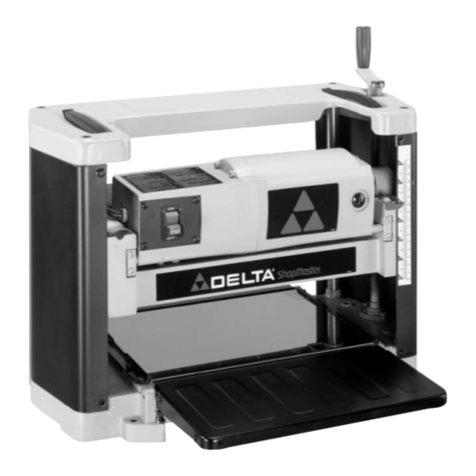
Delta
Delta ShopMaster TP300 User manual
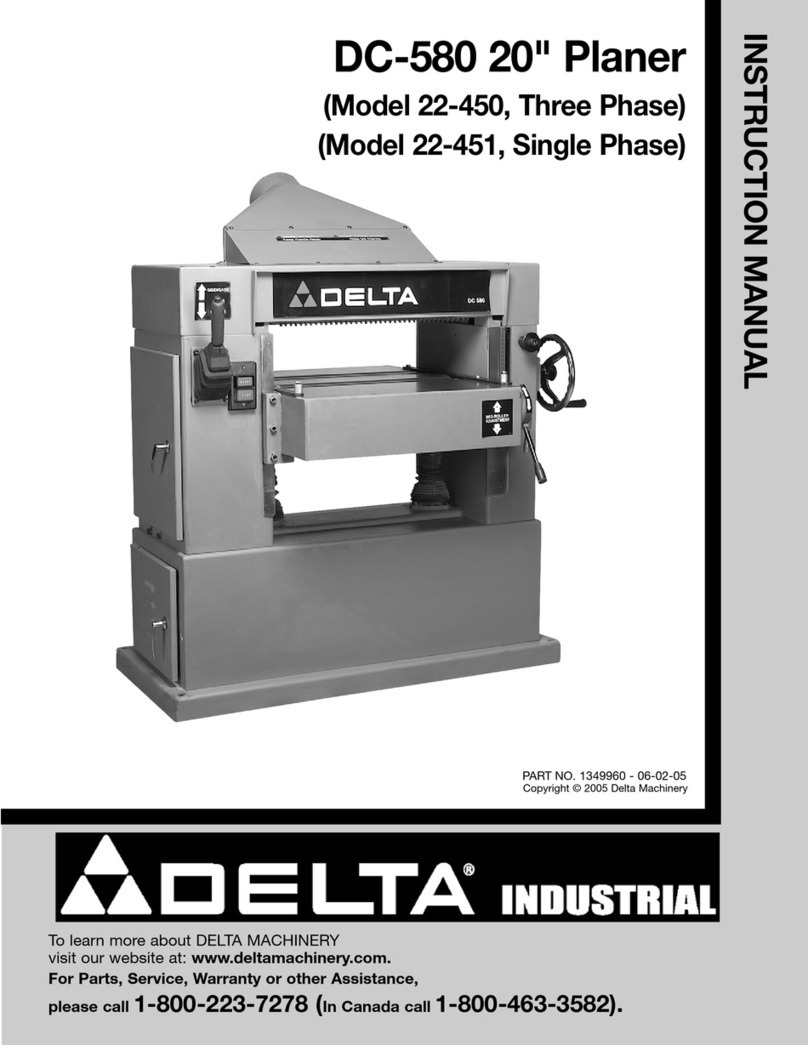
Delta
Delta DC-580 20" PLANER 22-450 User manual
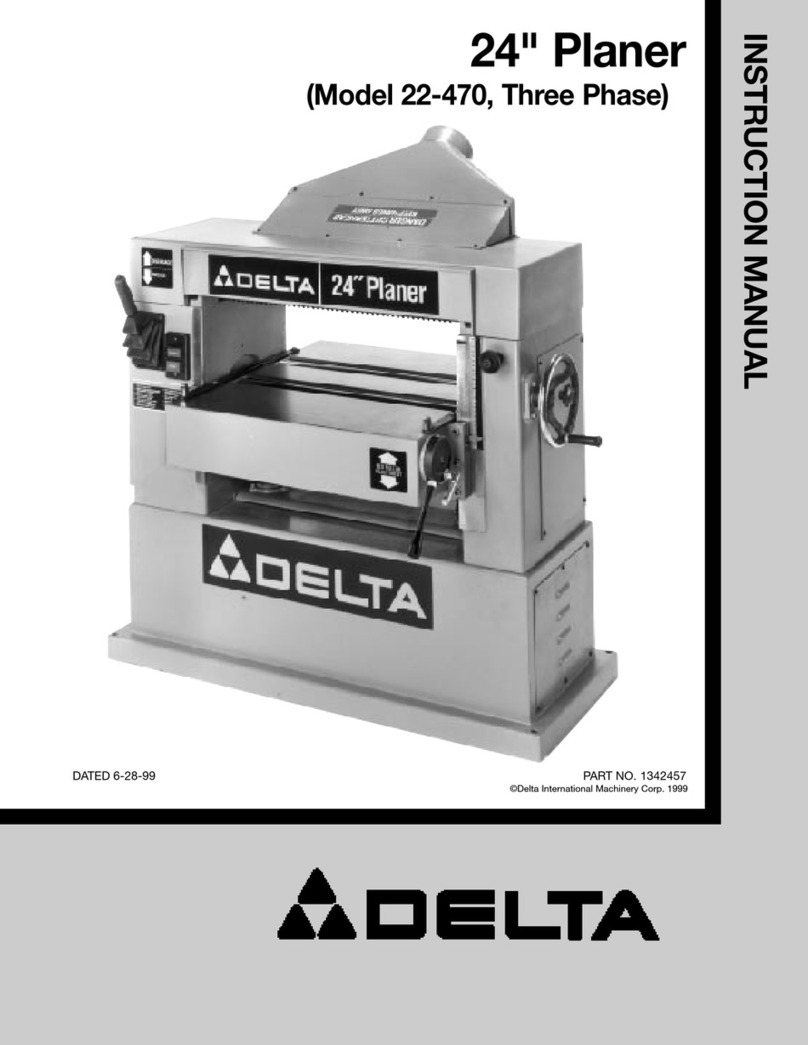
Delta
Delta 22-470 User manual
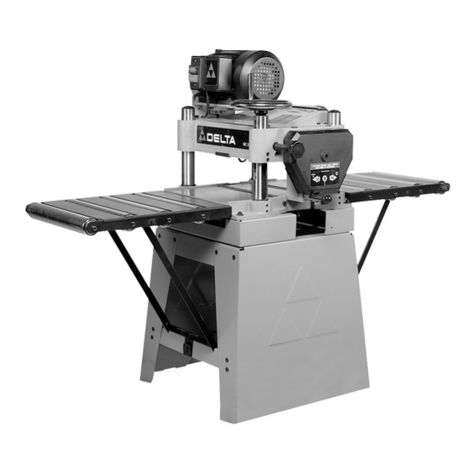
Delta
Delta 22-785 User manual
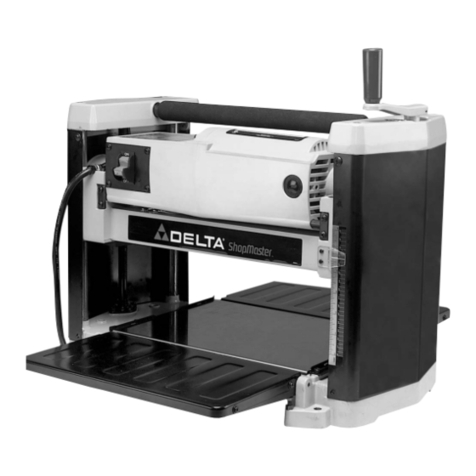
Delta
Delta TP305 User manual
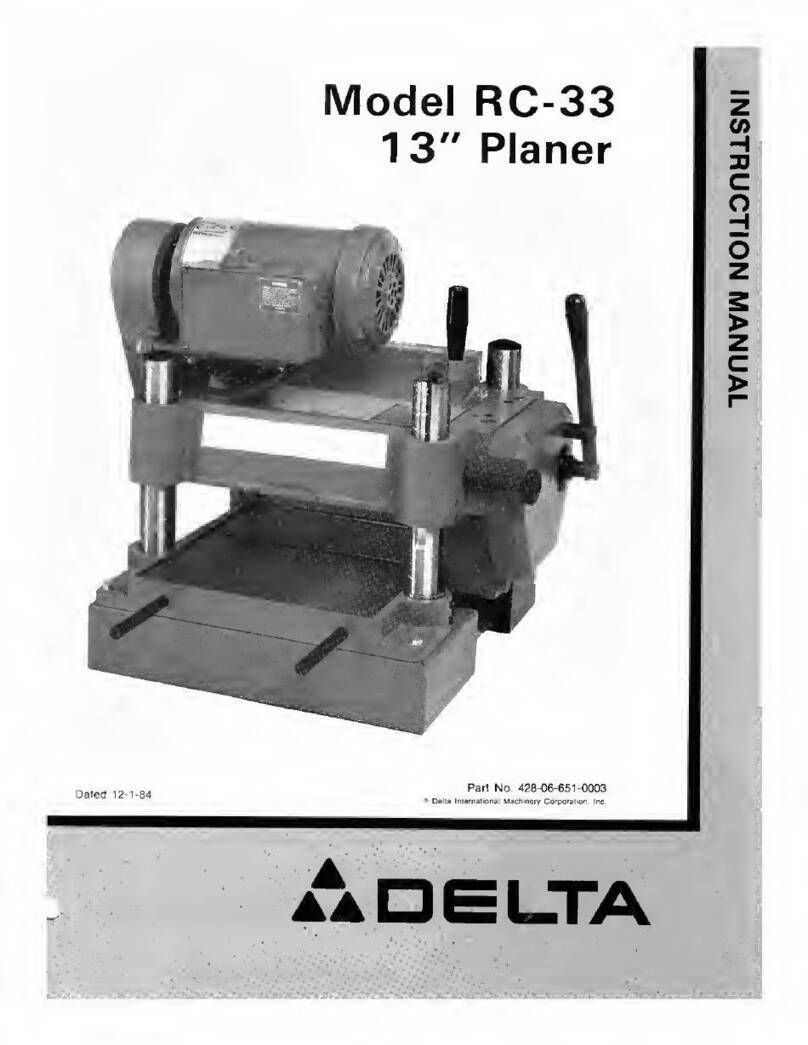
Delta
Delta RC-33 User manual
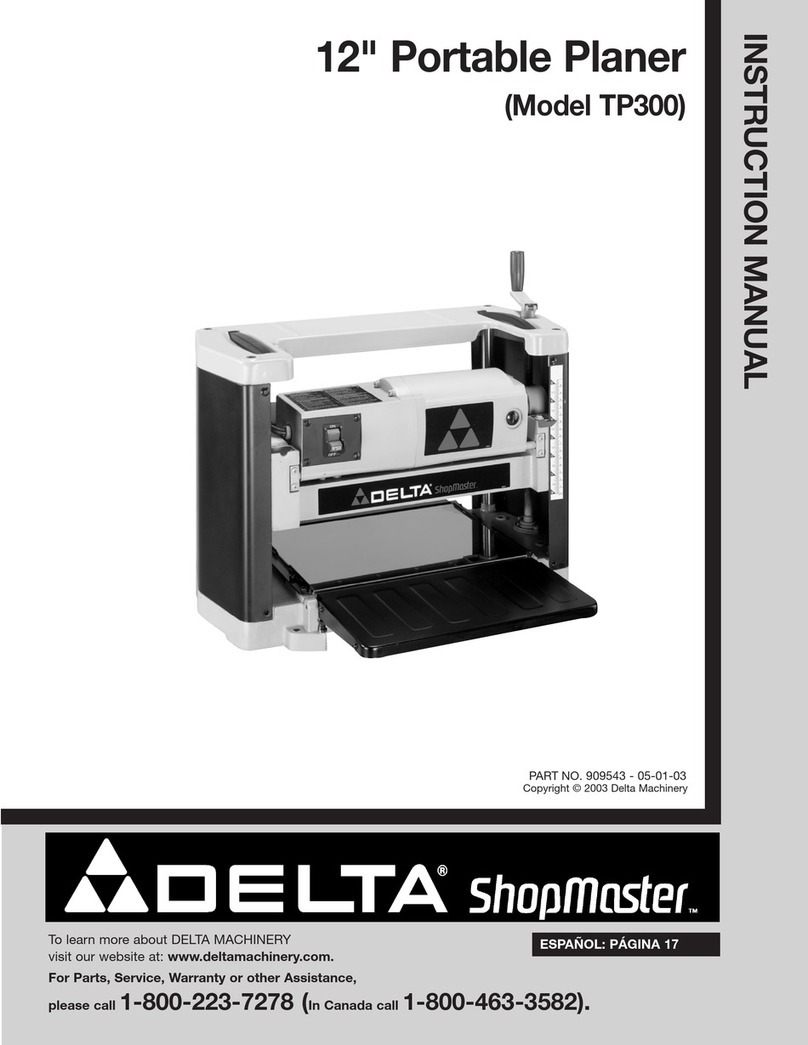
Delta
Delta ShopMaster TP300 User manual
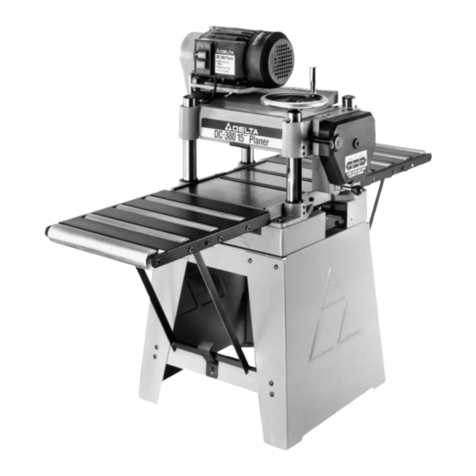
Delta
Delta 22-681 User manual
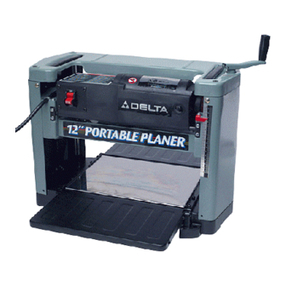
Delta
Delta 22-540 User manual
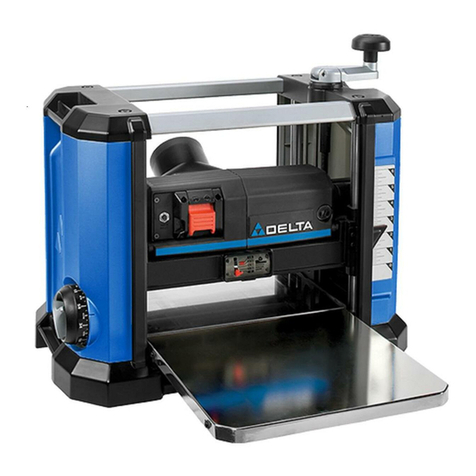
Delta
Delta 13" PORTABLE PLANER 22-590 User manual

